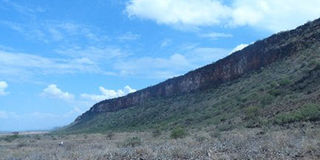The land of the birds

The vulture cliffs in the background of Lake Kwenia. PHOTO | KARIN FUEG
What you need to know:
- This amazing dryland tree has the most exquisite bouquet of flowers against the blue skies – cream, white and orange.
- Mixed with them are common kestrels, another migrant built for speed with their long narrow wings. But it’s the falcons that keep us enchanted.
- Rüppell’s vulture is listed as the highest-flying bird, seen in flight at an altitude of 37,000 feet above sea level. Considering that Mount Kilimanjaro – Africa’s tallest mountain – is 19,340 feet high, this bird is truly awesome.
At the break of dawn we’re on our way to Lake Kwenia, a little-heard-of place 95 kilometres south-west of Nairobi.
We’re treated to our first surrealist view of the Great Rift Valley from Corner Baridi.
The valley is shrouded in a white morning mist, hiding Mount Olorgesailie and Esakut and the low lying plains.
Driving through the ancient lake-bed of Olorgesailie we’re treated to dikdiks scampering across the road, Grant’s gazelles and ostrich. At Kamukuru we stop for breakfast arranged by Amyn Khan, an old friend from my university days.
His Maasai friend Billy Ntoyien Pelo, an architecture student, is our guide to the vulture cliffs.
The road leading to the lake and the cliffs is dusty, never tarmacked. Maasai herdsmen lead their thin cattle to the swamp and few watering points around. In this dry country, it’s the Delonix elata that colours the skies.
This amazing dryland tree has the most exquisite bouquet of flowers against the blue skies – cream, white and orange.
FALCONS EVERYWHERE
We’re far from Olorgesailie prehistoric site from where the cliffs can be seen. Circling the mountain to reach the vulture site, at some point, we’re off the road and where there are only paths. Pelo guides us through the dry country with the help of his Samburu friend.
And then they point to the lake – dry without a speck of water. Dr Darcy Ogada, the raptor specialist with The Peregrine Fund, says, “Stop! I think I’ve seen an Amur falcon.”
The driver stops and we scramble out of the car, where we’re met with something unexpected.
On almost every stone on the dry plains with sparse grass, there’s an Amur falcon perched. Scanning the plains with binoculars, we’re treated to Amur falcons, perched or hovering in the air to catch the grasshoppers around.
Amur falcons breed in China in the Amur Valley. To escape winter the birds fly to Africa – flying four days and four nights over the Indian Ocean. After winter they make the same journey back to China.
Mixed with them are common kestrels, another migrant built for speed with their long narrow wings. But it’s the falcons that keep us enchanted. “It’s the first time I’ve seen so many,” exclaims Darcy.
The sun is warming up and we have to hurry to the cliffs which we can see outlined in the horizon if we are to see Rüppell’s vultures.
By 11am most have flown off to the Maasai Mara, taking advantage of the rising warm air and scavenging on carrion to bring back food for the young.
HIGH-FLYING BIRDS
Driving over lava stones and loose soil until we can proceed no further, we walk towards the high red-orange cliffs which are steep and bare save for the whitewash at the very furthest edge.
It’s where the Rüppell’s vultures breed – one of the few sites in Kenya and the world.
Scanning the high cliffs with binoculars, what to the naked eye appears as dots are the vultures soaring.
Rüppell’s vulture is listed as the highest-flying bird, seen in flight at an altitude of 37,000 feet above sea level. Considering that Mount Kilimanjaro – Africa’s tallest mountain – is 19,340 feet high, this bird is truly awesome.
While we watch, some land, perching in the brackets of the cliffs. Dr Ogada estimates that there are about 30 pairs.
These amazing vultures are one of the largest vulture species found over east and central Africa, but populations are decreasing fast due to habitat loss, poisoning and in some places to use in witchcraft.
The current population is estimated to be 30,000 and it’s listed as endangered.




